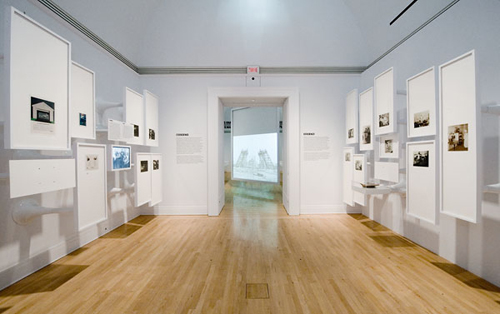
Canada’s CCA marks the futurist centenary by taking a lingering look at the cult of speed. Frederico Duarte hurried to see it
The Speed Limits banner on the facade of Montreal’s Canadian Centre for Architecture (CCA) shows a black and white photograph of an office, complete with dial telephones, typewriters and filing cabinets. This was once a showcase of technological and economic progress, but it now feels the farthest you can get from Marinetti’s dictum “the world’s magnificence has been enriched by a new beauty: the beauty of speed”, published 100 years ago. And that’s why it’s there.
The original 1965 photograph of the secretary pool in the North Carolina Mutual Life Insurance Building can be found in the fourth of the exhibition’s six rooms. Themed “Efficiency”, it shows how speed equalled progress, productivity and well-being in the 20th century’s two main workspaces: the office and the kitchen. Like other photographs, advertisements and promotional videos from both sides of the Iron Curtain, it is a testament to a time when the hardest part of baking a cake was adding an egg to the instant mix and Xerox machines were the state of the art. It also shows where the futurist avantgarde’s exhilaration over speed met the contingent spaces and bodies of the common man. In the tense space between beauty and boredom, utopia and reality, the heroic and the mediocre, curator Jeffrey T Schnapp has found fertile ground for exploring modernity’s love affair with speed – but also its consequences, from overcrowded cities to over-stimulated brains.
A collaboration between three institutions – Stanford University (where Schnapp is the Pierotti Chair in Italian Literature and Humanities Lab founder), the Wolfsonian-Florida International University and the CCA – Speed Limits is an academically rigorous yet sensorially captivating show, and the latest in CCA’s worldclass series of thought-provoking, topical approaches to our designed and built environments.
Passenger statistics and vehicle accident studies encircle the Traffic room’s TV screen centrepiece, where nine cities are navigated at speeds only possible in a virtual, Formula One video game reality. In Fast Construction, building is shown as performance, from 1920s Sears prefab housing catalogues to stop-motion videos of the erection of the Eiffel and CCTV Towers, opposite a selection of demolition methods. In Mind and Body, Eadweard Muybridge’s “Animal Locomotion” studies share counter space with natural and synthetic stimulants and sedatives.
From a photograph showing Marinetti’s car wrecked in a ditch to Kem Weber’s streamlined Zephyr clock, all of Speed Limits’ contents are presented as artefacts stripped of irony or nostalgia, steering the exhibition away from other more frenzied commemorations of the futurist centenary, or from celebrating speed for speed’s sake. It does however leave you with the uneasy feeling that everything we consider progress may in the future change gears, slow down or even come to a halt – and that is no small feat.
Speed Limits is at the CCA, Montreal, until 12 October www.cca.qc.ca
This review was published on the August 2009 issue of icon magazine. My editor for this piece was Will Wiles.
Comments are closed.